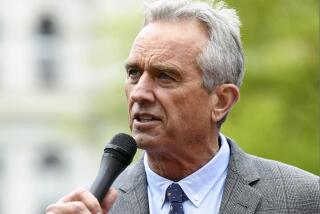Stem Cell Initiative Attracts Backers
- Share via
The campaign for a ballot initiative that would provide $3 billion in state money for research into embryonic stem cells has reported more than $10.7 million in contributions, giving it a large financial edge over opponents.
The opposition to the initiative, Proposition 71, has reported $75,000.
The case for spending billions on stem cell research will be made throughout the fall with a “very aggressive paid media campaign including television, radio and mail,” said Fiona Hutton, a spokeswoman for the Yes on 71 campaign
With far less money in the bank, those working against the measure said their side will focus on getting its message across through news coverage, talk radio and other means that do not involve paid advertising.
“This is one that’s not going to be bought and paid for by the side that can buy the most paid TV ads,” said Wayne Johnson, a Republican consultant who is helping coordinate the campaign against Proposition 71.
Many donors favoring the initiative have family members who suffer from diseases they believe stem cell research could help cure. Other donors include venture capitalists and people with ties to the technology and biotechnology industries.
In August, the initiative’s backers raised more than $2.1 million, including a $400,000 donation from Microsoft founder Bill Gates, $100,000 from Sen. Jon Corzine (D-N.J.) and more than $51,000 from Los Angeles billionaire Eli Broad.
In addition, EBay founder Pierre Omidyar and his wife, Pamela, have donated more than $1 million. The Juvenile Diabetes Foundation, based in New York, has donated $1 million. So too did John and Ann Doerr, generous donors to Democratic party causes. John Doerr is a venture capitalist and investor in Google.
Much of the seed money for the proposition came from Robert Klein II, a Fresno real estate developer who has given more than $1.5 million. His son has juvenile diabetes and his father suffers from Alzheimer’s disease.
For many who have given money to help pass the initiative, the potential promise of stem cell research is deeply emotional.
Jackie Scandalios of Atherton, Calif., said she tracked down Proposition 71 organizers earlier this year to donate $100.
“We have a daughter who is very ill with lupus,” said Scandalios. “It seems [this research] may probably be a last resort.”
Scandalios compared the potential for stem cell research to the Salk vaccine -- which transformed polio from a dreaded disease into one that has been virtually eradicated in most nations.
Johnson said he understands that many donors “are willing to grasp at anything that offers hope. People who have resources travel the world looking for any treatment they can find.” But he said he believes their faith in stem cell research is misplaced.
The largest donation to the anti-Proposition 71 committee, which is called Doctors, Patients and Taxpayers for Fiscal Responsibility, was $50,000 from Fieldstead and Co. in Irvine, owned by Howard Ahmanson Jr. Ahmanson is a philanthropist who has a long history of backing conservative causes.
On a California ballot crowded with propositions for voters to consider, the question of whether to fund stem cell research is likely to be among the most divisive and closely watched.
Proposition 71 calls for the state to bankroll research currently ineligible for federal money under a decision made by President Bush in 2001. Bush allowed federal dollars to be used for embryonic stem cell research but he limited funding to groups of cells, known as cell lines, that were already in existence at the time of his decision. Advocates and researchers argued that the existing embryonic stem cell lines were insufficient.
Stem cells from embryos can copy themselves indefinitely and become every type of cell in the human body. By studying how such cells work, scientists believe they can better understand disease.
Advocates of the research say that embryonic stem cells potentially could be used to create new insulin-producing cells in the bodies of people with diabetes. Others hope stem cells could be used to regrow nerve cells in people paralyzed by accidents or cure Alzheimer’s disease. Researchers stress that their work is still very preliminary and far from producing cures.
Stem cells are also found in umbilical cord blood and some adult tissues. But researchers disagree about whether those stem cells have as much potential as the ones found in embryos.
Supporters of research using embryonic stem cells say the cells can be taken from embryos created for in vitro fertilization but not used. Such embryos could be donated by the individuals whose eggs and sperm were used to create them.
Proposition 71 also makes money available for embryonic stem cells created through a process that advocates sometimes call therapeutic cloning, in which the DNA of an unfertilized egg is replaced with the DNA of an individual. The embryo created would produce stem cells that are a genetic match with the donor, potentially allowing treatments with no risk of rejection by the donor’s body.
The initiative bans cloning for reproductive purposes.
Advocates of the research say that if the work could cure diseases, it would be unethical not to do it.
By contrast, many opponents of the initiative say human embryos should never be used for research.
Beyond that clash of values, Gov. Arnold Schwarzenegger and others have raised questions about whether the state can afford the $3-billion bond that the ballot proposition calls for. With interest, the measure would cost an estimated $6 billion.
Opponents argue that the money, which would dwarf funding for other areas of scientific research in the state, would be earmarked with no guarantees that cures will be derived.
Supporters of the measure say that passage of the ballot initiative would benefit taxpayers by attracting top scientists and researchers to the state and spurring job creation.
Partisan differences also factor into the debate. Although some prominent Republicans, including former First Lady Nancy Reagan, support stem cell research, some Democratic strategists see the issue as a potent one to use against Bush.
Nationally, a Times poll conducted last week reported that two-thirds of registered voters now say they support embryonic stem cell research.
Statewide, in a Field Poll released Aug. 15, 45% of voters said they planned to vote for Proposition 71, 42% said they would vote against it and 13% were undecided. The Field Poll also found that 40% of voters said they were familiar with the measure.
With that level of public awareness, the massive gap in fund-raising between the two sides may not matter, said Larry Gerston, a political science professor at San Jose State.
“The cynics will tell you money always wins an election,” Gerston said. “Money can make a difference when people haven’t been paying attention, but money doesn’t always win.”
Even with a lot of money, supporters of Proposition 71 “may well be drowned out” by the cacophony of political messages expected in the coming weeks, Gerston said. “Support below 50% makes it pretty easy for the negative side to win,” he said, referring to the findings of the Field Poll. “People who remain undecided tend to vote overwhelmingly no.”
Jack Pitney, a political science professor at Claremont McKenna College and former national Republican Party strategist, predicted that the supporters of the initiative are “going to need that money.”
“You have voters who may be uncomfortable with the whole question of stem cell research, and even if you don’t get into that part of the debate, many people might say: ‘This is a nice idea, but the state is already in the hole and we just can’t afford it.’ ”
Still, Gerston said, “this is a great initiative to watch because California is so often on the cutting edge when it comes to social issues. If it could pass anywhere, this is as likely a place as any.”
Times researcher Maloy Moore contributed to this report.
More to Read
Get the L.A. Times Politics newsletter
Deeply reported insights into legislation, politics and policy from Sacramento, Washington and beyond. In your inbox twice per week.
You may occasionally receive promotional content from the Los Angeles Times.











